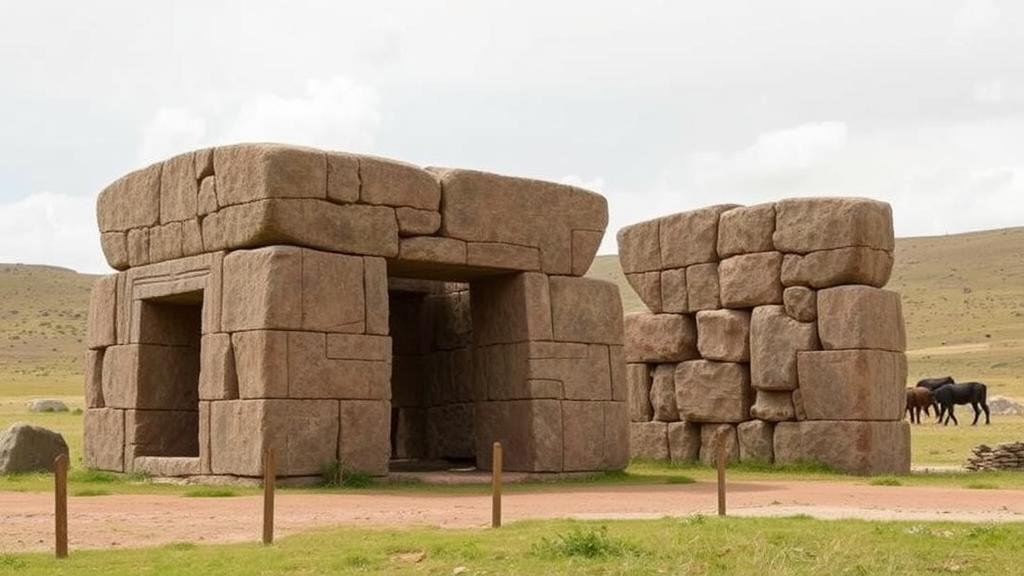Exploring the “Stone Altar of Pumapunku,” a site in Bolivia featuring precision stonework.
Exploring the Stone Altar of Pumapunku
The Stone Altar of Pumapunku, located in the highlands of Bolivia near the town of Tiwanaku, is an archaeological wonder that showcases the advanced engineering and precision stonework of ancient civilizations. Dating back to approximately 536 AD, this site is part of a larger complex of structures that include the famous Tiwanaku ruins. What sets Pumapunku apart is its remarkable stone craftsmanship that continues to intrigue scholars and visitors alike.
The Location and Historical Significance
Pumapunku is situated at an elevation of about 3,900 meters (12,800 feet) above sea level, just south of the Lake Titicaca basin. This strategic location offers insights into the religious and cultural significance of the site, as it is believed to have served as a ceremonial center for the Tiwanaku culture. The complex includes large stone platforms, monolithic blocks, and intricately carved fragments that reveal a sophisticated level of architectural design.
The Tiwanaku culture, which thrived around 400 to 1000 AD, was, at its peak, one of the most influential civilizations in the Andes region. Pumapunku, along with Tiwanaku, is evidence of the society’s capabilities in agriculture, trade, and engineering–all contributing to its status as a powerful regional hub.
Precision Stonework: An Overview
One of the most striking features of the Stone Altar of Pumapunku is its precision stonework. site consists of large stone blocks made of red sandstone and other materials, with some blocks measuring up to 7 meters (23 feet) in length and weighing several tons.
Archaeologists have noted that the stones were cut with such precision that they fit together seamlessly, without the use of mortar. In fact, some researchers believe that the level of craftsmanship displayed at Pumapunku is unparalleled in the ancient world. For example, the stones were shaped with right angles and dressed with flat surfaces, indicating advanced knowledge of tools and techniques.
- Blocks align with such exactness that a thin piece of paper cannot fit between them.
- There are signs that some blocks were drilled with circular tool marks, suggesting sophisticated drilling technology.
Engineering Marvels: Theological and Astronomical Aspects
The architecture of Pumapunku is not only a testament to the skill of its builders but also reflects their cosmological beliefs. arrangement of structures and the orientation of the stone altars appear to align with astronomical events. For example, during the equinoxes, certain alignment features are noted to correspond with celestial bodies.
This connection to the cosmos can be compared to Stonehenge in England, where the positioning of stones is believed to relate to astronomical observations. Just as Stonehenge served as a calendar for its culture, Pumapunku may have played a similar role, anchoring the communitys rituals to celestial events.
Challenges in Understanding Pumapunku
Despite its glory, the Stone Altar of Pumapunku faces several challenges in terms of preservation and interpretation. Natural erosion, human activity, and weathering have taken a toll on the site. Also, the lack of written records from the Tiwanaku civilization complicates our understanding of its purpose and significance.
Plus, the controversial theories regarding how such massive stones were transported and manipulated, including the possible use of sledges or rolling stones, generate debate among historians and archaeologists. Some propose that the technology employed was advanced for its time, while others suggest that the techniques may remain lost to history.
Real-World Applications and Preservation Efforts
The study of Pumapunku not only enriches our understanding of ancient technology but also informs contemporary engineering practices. precision seen in the stonework offers lessons in materials science and construction techniques that could inspire modern architects and engineers.
Preservation efforts are essential to maintaining the integrity of the site for future generations. Organizations, including the Bolivian government and international archaeological groups, are actively working to protect Pumapunku from the effects of tourism and environmental factors. Educating visitors on the importance of respecting the site can help ensure its longevity.
Conclusion: The Legacy of Pumapunku
The Stone Altar of Pumapunku stands as a remarkable testament to the ingenuity of the Tiwanaku culture. Its precision stonework and architectural significance offer valuable insights into ancient engineering and cosmological beliefs. As ongoing research unveils further details about this enigmatic site, it continues to captivate the imagination of those who seek to understand the mysteries of our human past.
Visitors to Pumapunku are not only witnesses to a historical site but also participants in a dialogue about the ingenuity of ancient civilizations and the lessons they impart for contemporary society.



